AMD Ryzen 9 9950X3D Desktop Processor Review
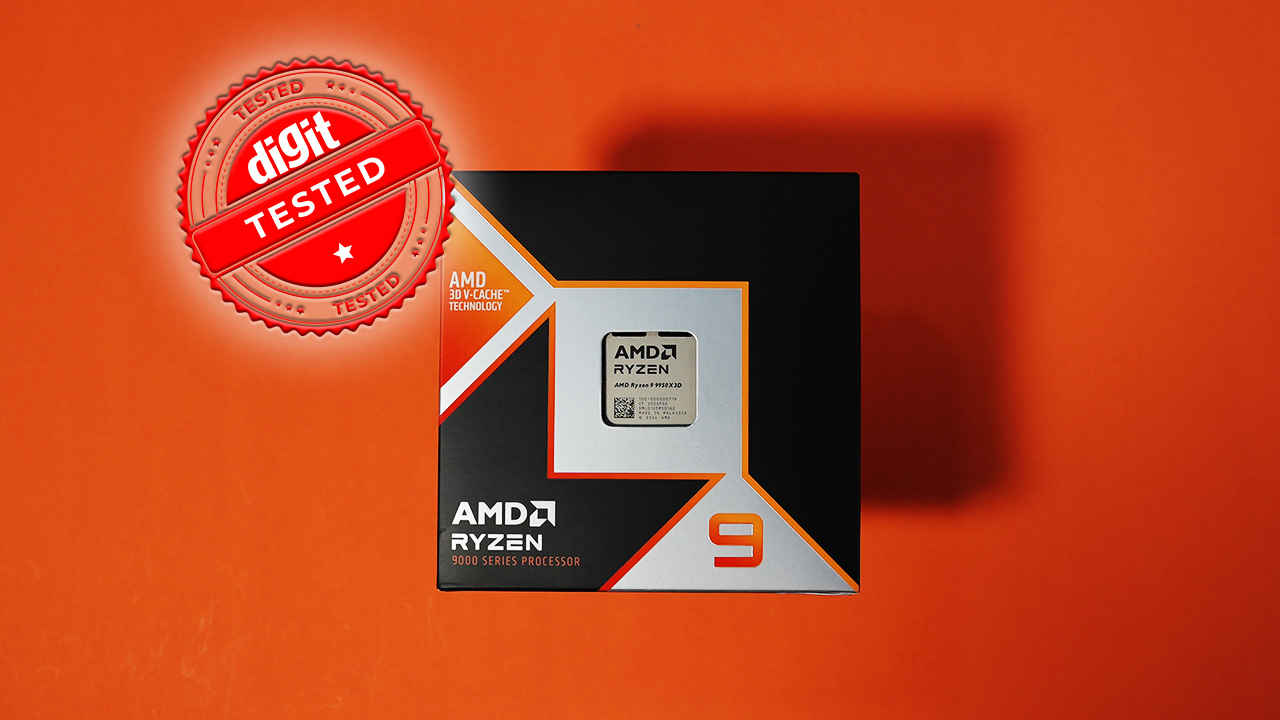
- Great gaming performance
- Inbuilt GPU
- High Power Consumption
- High Price
With the AMD Ryzen 9 9950X3D, Team Red has completed the launch of the high-end segments within the new 9000 series processor, albeit it does seem like that older non-X3D processors might be passed over considering how good the X3D processors have been performing. And with the competition lying low, the time is right for AMD to carve an even larger chunk of the desktop processor market share. We’ve reviewed the AMD Ryzen 7 9800X3D previously, and we were quite impressed by the way it managed all sorts of different workloads, from gaming to content creation. Although, there were a few workloads where either the competition shone or AMD’s own higher core-count processors took the crown. With the AMD Ryzen 9 9950X3D, we expect AMD to knock it out of the park in practically every scenario. Let’s find out if the 9950X3D is indeed the pinnacle of AMD’s Zen 5 family.
AMD Ryzen 9 9950X3D Specifications
In a way, the AMD Ryzen 9 9950X3D is practically the same as the AMD Ryzen 9 7950X3D in most aspects. Obviously, the improved architecture does bring several enhancements, including the improved L1 cache slightly better base clocks and support for higher memory speeds. Unfortunately, there’s also a much higher TDP of 170 Watts for the 9950X3D which makes it a power-hungry processor. The lower base clocks compared to the 9800X3D will mean that the performance of the 9950X3D will be lower in quite a few benchmarks but the higher TDP might compensate for that and there’s the possibility that you might get some extra performance. We’ll let the benchmarks do the talking.
| AMD Ryzen 9 9950X3D Specifications | ||||||
| AMD | AMD | AMD | Intel | AMD | AMD | |
| Model | Ryzen 9 7950X3D | Ryzen 7 9700X | Ryzen 9 9950X | Core Ultra 9 285K | Ryzen 9 9800X3D | Ryzen 9 9950X3D |
| Price | 65699 | 35999 | 65999 | 58900 | 47900 | 70000 |
| Socket | AM5 | AM5 | AM5 | LGA 1851 | AM5 | AM5 |
| Codename | Raphael | Granite Ridge | Granite Ridge | Arrow Lake-S | Granite Ridge | Granite Ridge |
| Foundry | TSMC | TSMC | TSMC | TSMC | TSMC | TSMC |
| Core Process | 5 nm | 4 nm | 4 nm | 3 nm | 4 nm | 4 nm |
| Core Architecture | Zen 4 | Zen 5 | Zen 5 | Lion Cove & Skymont | Zen 5 | Zen 5 |
| Die Size | 71 mm2 | 70.6 mm² | 2x 70.6 mm² | 243 mm² | 70.6 mm² | 2x 70.6 mm² |
| I/O Process | 6 nm | 6 nm | 6 nm | 6 nm | 6 nm | 6 nm |
| I/O Die Size | 122 mm2 | 122 mm² | 122 mm² | 243 mm² | 122 mm² | 122 mm² |
| tCaseMax | 89°C | 95°C | 95°C | 105°C | 95°C | 95°C |
| Launch Date | 28-Feb-2023 | 8-Aug-2024 | 8-Aug-2024 | 24-Oct-2024 | 7-Nov-2024 | 11-Mar-2025 |
| Cores | 16 | 8 | 16 | 24 | 8 | 16 |
| – Big Cores | 16 | 8 | 16 | 8 | 8 | 16 |
| – Small Cores | 0 | 0 | 0 | 16 | 0 | 0 |
| Threads | 32 | 16 | 32 | 24 | 16 | 32 |
| Integrated Graphics | 1 | 1 | 1 | 1 | 1 | 1 |
| Integrated Graphics | RDNA2 | RDNA2 | RDNA2 | Intel Xe-2 64EU | RDNA2 | RDNA2 |
| Integrated Graphics Cores | 2 | 2 | 2 | 4 | 2 | 2 |
| IG Base Frequency | 400 MHz | 400 MHz | 400 MHz | 300 MHz | 400 MHz | 400 MHz |
| IG Turbo Frequency | 2200 MHz | 2200 MHz | 2200 MHz | 2000 MHz | 2200 MHz | 2200 MHz |
| Cache L1 | 64 | 80 | 80 | 112 | 80 | 80 |
| Cache L2 | 1 | 1 | 1 | 3 | 1 | 1 |
| Cache L3 | 128 | 32 | 64 | 36 | 96 | 128 |
| Big Core Base Frequency | 4.2 | 3.8 | 4.3 | 3.7 | 4.7 | 4.3 |
| Big Core Turbo Clock | 5.7 | 5.5 | 5.7 | 5.7 | 5.2 | 5.7 |
| Small Core Base Frequency | NA | NA | NA | 3.2 | NA | NA |
| Small Core Turbo Clock | NA | NA | NA | 4.6 | NA | NA |
| Max Memory Capacity | 128 | 192 | 192 | 192 | 192 | 192 |
| Rated Memory Clock Speed | 5200 | 5600 | 5600 | 6400 | 5600 | 5600 |
| TDP | 120 | 65 | 170 | 125 | 120 | 170 |
With all three Cache memory tiers considered, we do get a higher amount of Cache on the 9950X3D and that will be beneficial in some gaming workloads. The lack of a dedicated NPU seems to have been the biggest loss in the sea of noteworthy improvements. Although, adding an NPU on a 16-Core processor would have taken the TDP up by quite a bit. Perhaps, we’ll see that in the next generation.
AMD Ryzen 9 9950X3D Test Rig
We received a full kit with new AMD Ryzen 9 9950X3D processor, SSD, and memory sticks. We didn’t use the provided SSD and stuck to our own storage drives. Here’s the full specs:

- CPU: AMD Ryzen 9 9950X3D
- Motherboard: X870E AORUS MASTER
- RAM: 2x G.Skill Trident Z5 16 GB
- SSD: Kingston Renegade PCIe Gen 4.0 SSD
- Cooler: Corsair iCUE Link Titan X360 RX LCD
- PSU: Cooler Master MWE Gold 850 V2
AMD Ryzen 9 9950X3D Performance
Cinebench 2024
Cinebench 2024 is based on Maxon’s Cinema 4D software, designed to evaluate a processor’s performance in rendering complex 3D scenes. It tests both single-core and multi-core capabilities, highlighting how efficiently a CPU handles multi-threaded tasks common in professional rendering workflows. The benchmark utilizes modern instruction sets and large datasets, providing an up-to-date assessment of CPU performance in contemporary applications.
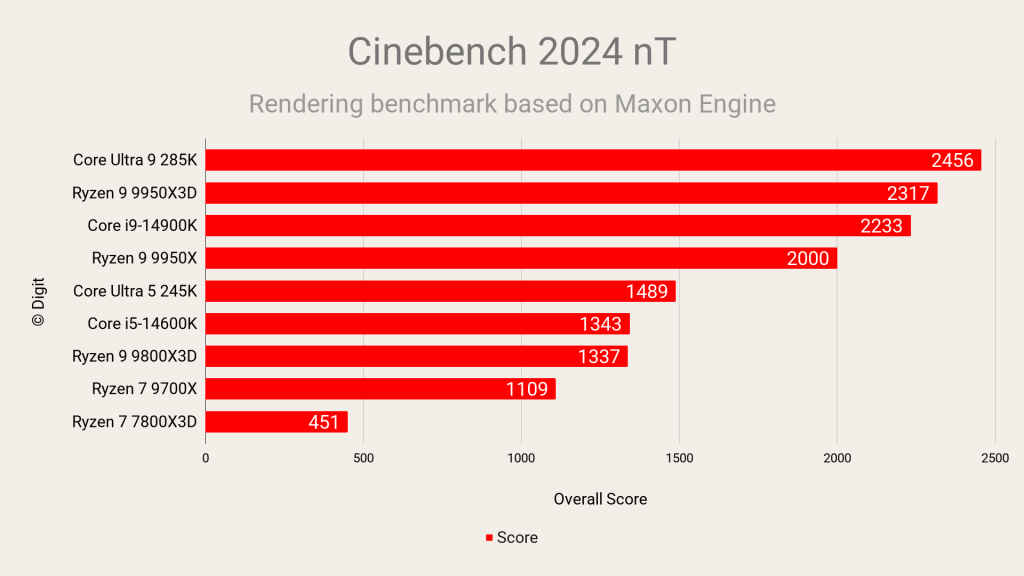
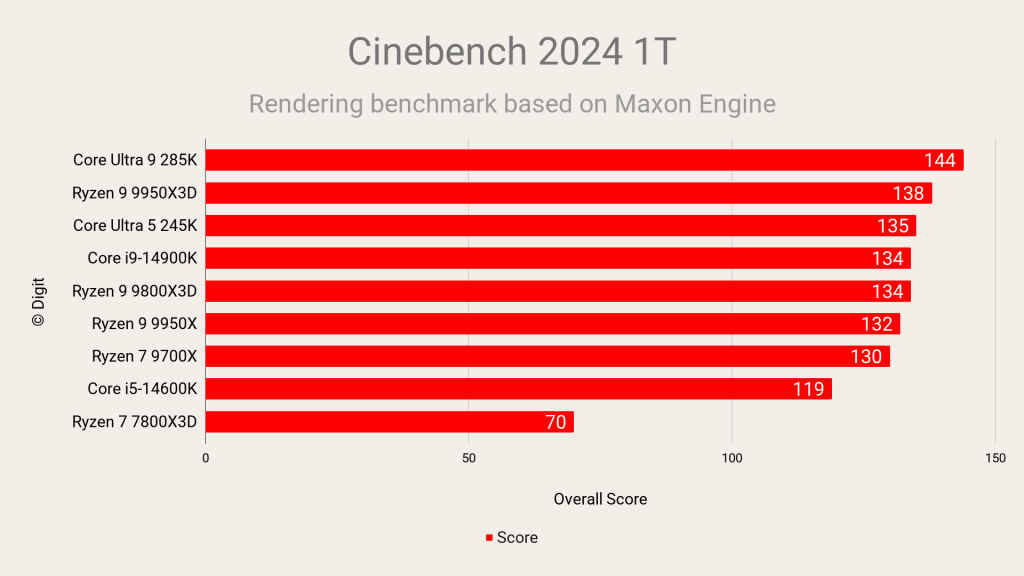
Cinebench R23
Cinebench R23 is the older version based on the same Cinema 4D engine and it too measures a processor’s ability to render photorealistic 3D scenes. Though replaced by Cinebench 2024, we retain it to compare against processors launched a few years prior. It also focuses on both single-threaded and multi-threaded performance, simulating real-world tasks relevant to content creators and professionals in 3D rendering.

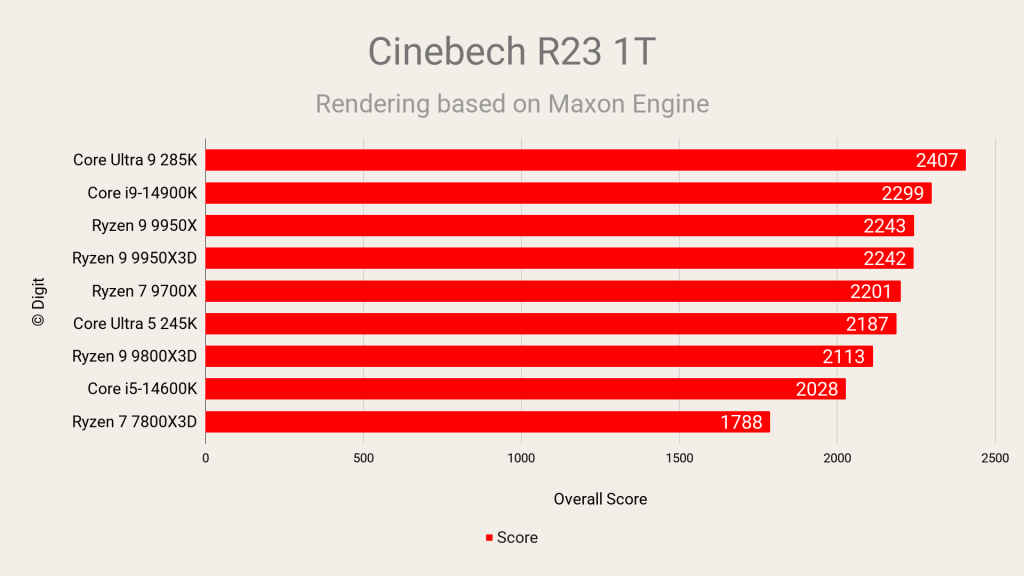
Blender
The Blender Benchmark assesses a processor’s performance by rendering scenes using Blender, a popular open-source 3D creation suite. It evaluates both CPU and GPU capabilities in handling complex rendering tasks. This benchmark provides insights into how well a processor performs in real-world 3D modeling, animation, and rendering scenarios. An interesting aspect is that it highlights the efficiency of different CPU architectures in multi-threaded workloads, as Blender can effectively utilize multiple cores. It’s particularly useful for professionals and enthusiasts relying on Blender, indicating how hardware upgrades might impact workflow efficiency and rendering times.
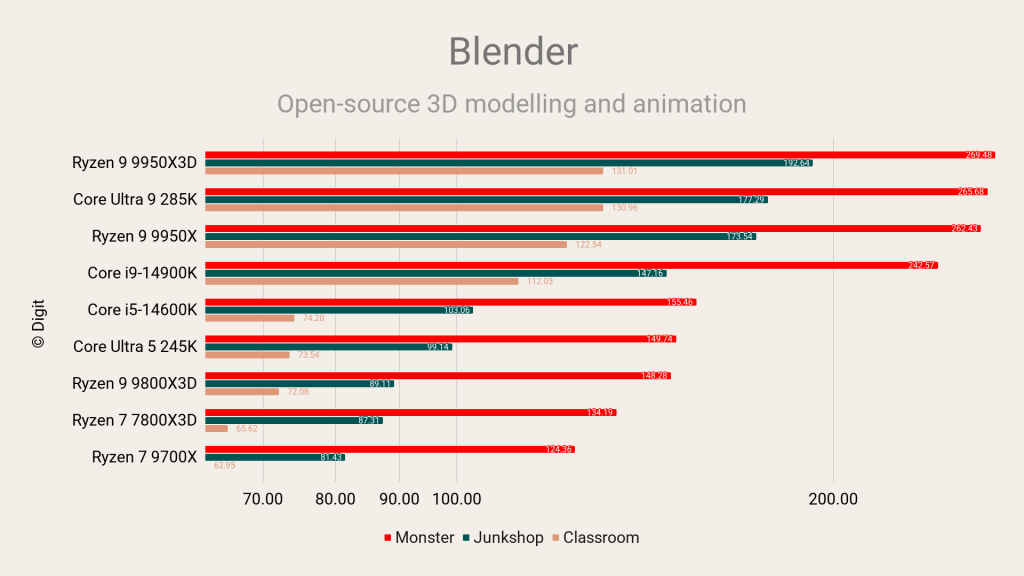
V-Ray
V-Ray is another benchmark that measures a processor’s performance in rendering but it uses the V-Ray engine, widely used in visual effects, architecture, and design industries. It tests both CPU and GPU rendering capabilities, focusing on multi-threaded performance and handling complex calculations involved in ray tracing. CPUs with higher core counts and multi-threading technology tend to excel here as V-Ray efficiently utilises available threads.
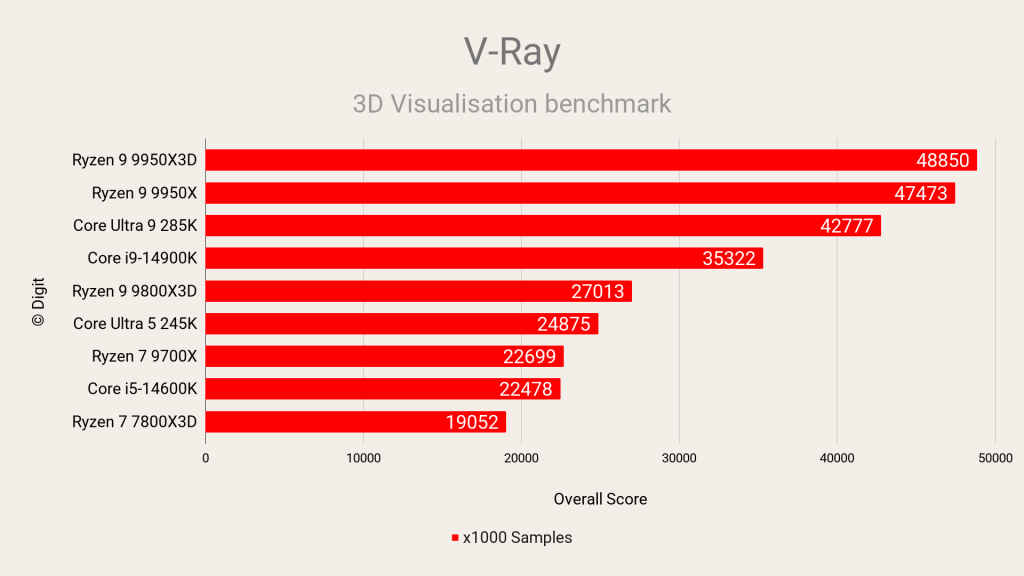
WinRAR
WinRAR Benchmark evaluates a processor’s performance in data compression and decompression tasks, common in file archiving and management. It tests single-threaded performance, memory bandwidth, and latency, as these factors influence compression speed. While WinRAR isn’t fully optimized for multi-core CPUs, processors with higher Instructions Per Cycle (IPC) and clock speeds perform better. For more modern algorithms, we use 7-Zip.

AIDA64
AIDA64 Memory Benchmark measures the memory bandwidth and latency of a system, highlighting how quickly data transfers between the CPU and RAM. It tests read, write, and copy speeds, providing insights into the efficiency of the memory subsystem, including RAM speed, timings, and memory controller performance. AIDA64 also has benchmarks to evaluate how well a processor can handle AES, ZLib and SHA3 encryption and decryption tasks.

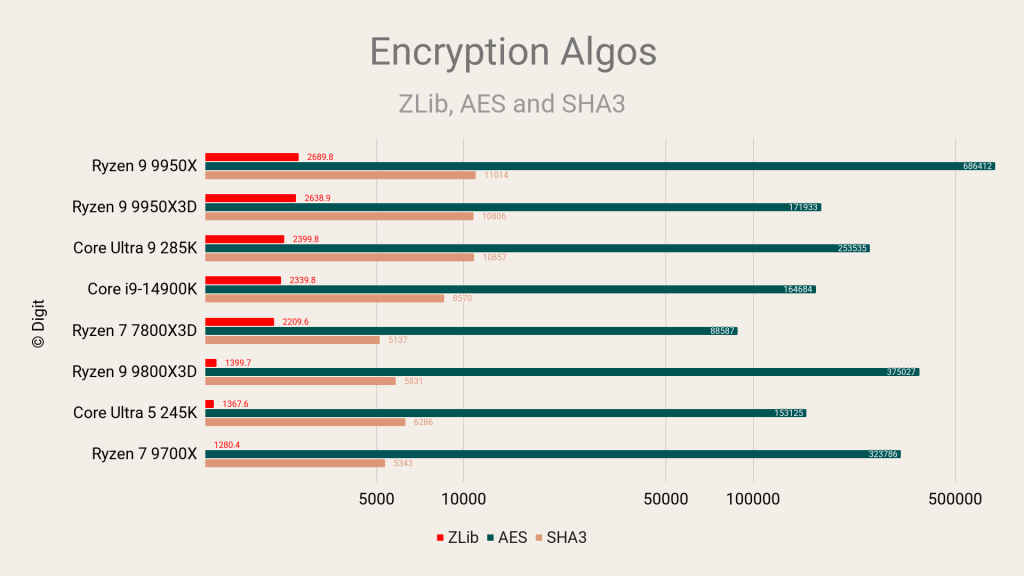
y-cruncher
The y-cruncher benchmark computes mathematical constants like Pi to a high number of digits—in this case, 2.5 billion—testing a processor’s multi-threaded performance and memory subsystem under heavy computational load. It stresses the CPU’s integer and floating-point units, cache hierarchy, and memory bandwidth. It’s particularly useful for evaluating system stability under sustained heavy workloads, making it valuable for users who are overclocking their systems.
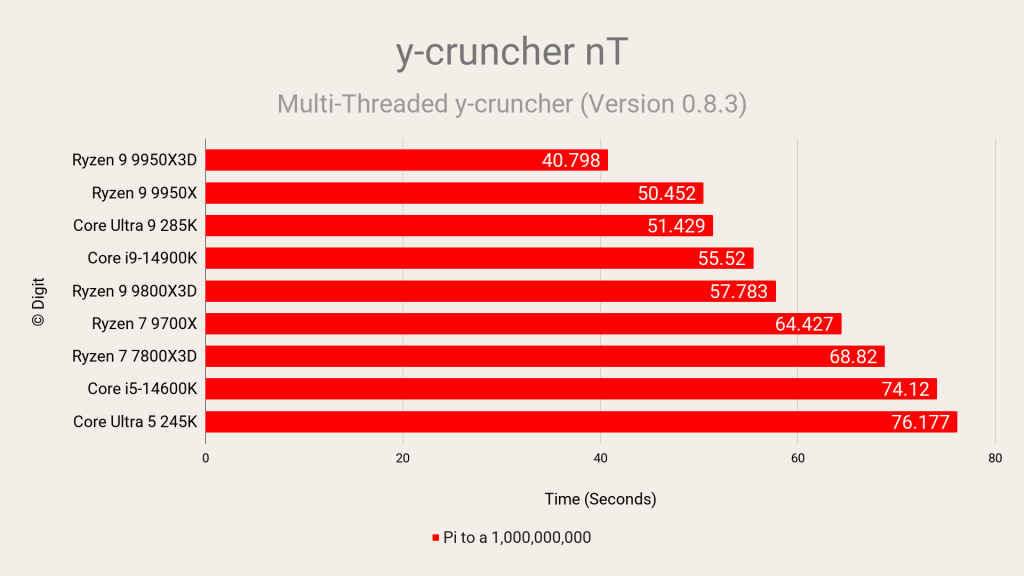
Procyon Office
The Procyon Office Benchmark measures a processor’s performance in real-world office applications like the Microsoft Office suite, testing tasks such as document editing, spreadsheet calculations, and presentation creation. It focuses on both single-threaded and multi-threaded performance, providing insights into how a CPU handles everyday productivity tasks.
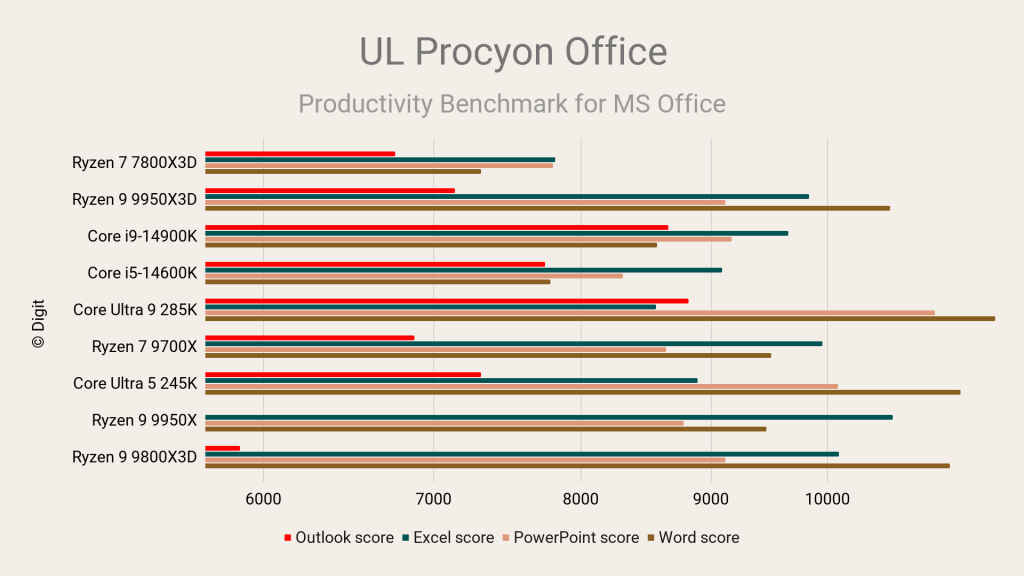
Mozilla Kraken & Google Octane
Mozilla Kraken and Google Octane are JavaScript benchmarks evaluating a processor’s performance in executing complex web-based scripts, reflecting real-world web application usage. It tests single-threaded performance and the efficiency of a CPU’s instruction pipelines in handling dynamic scripting languages.
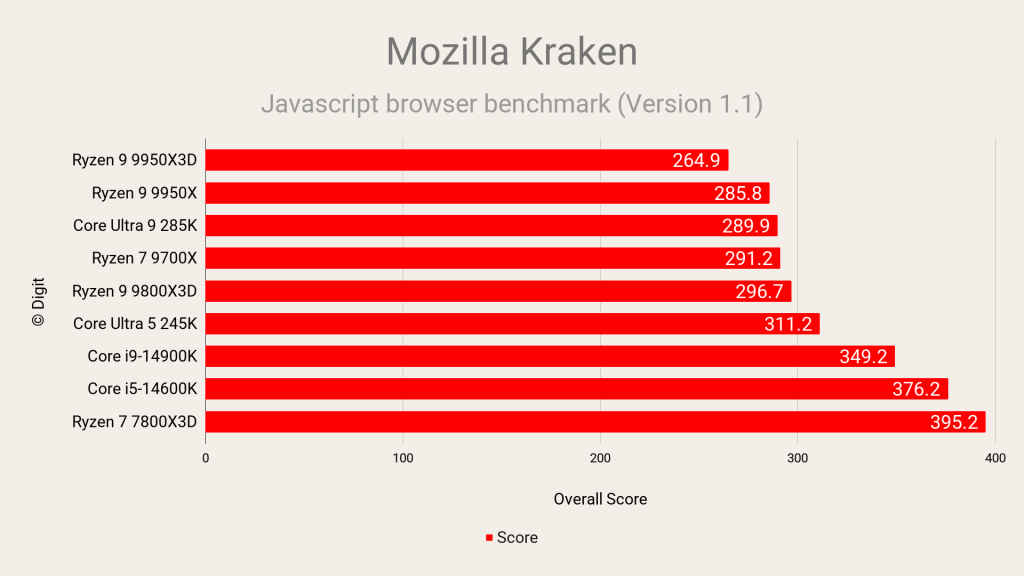
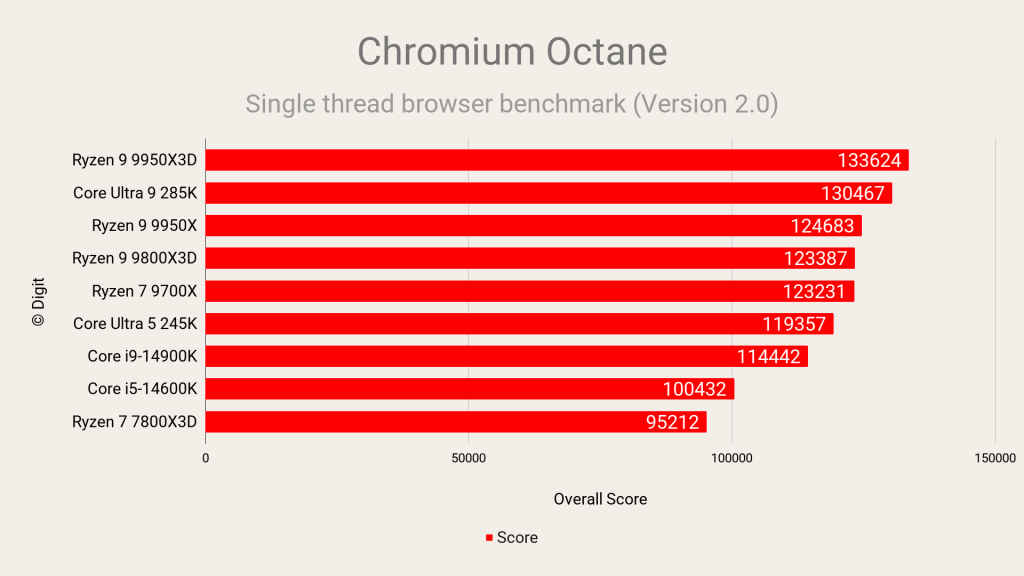
Procyon AI Computer Vision
The UL Procyon AI Computer Vision benchmark measures the performance of AI inference engines to understand how well processors can handle machine-vision tasks using popular neural networks.
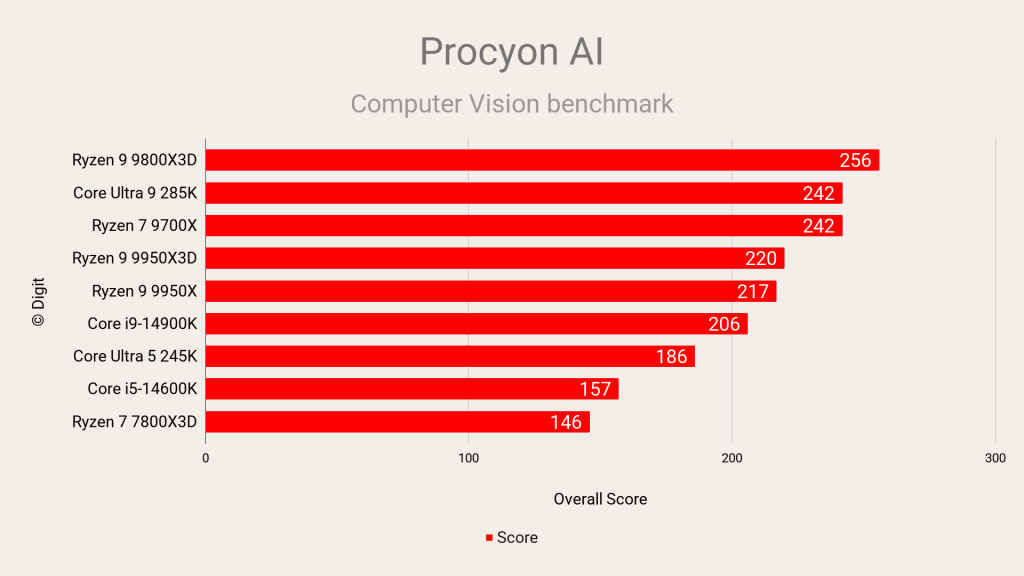
3DMark Time Spy (iGPU)
3DMark Time Spy is a DirectX 12 benchmark evaluating graphics performance. We use it primarily to test the relative performance of the iGPU to discrete GPUs and where iGPUs stand amongst their peers. With both companies improving their integrated graphics stack, it allows us to measure how well the iGPU performs and if it can handle popular eSports titles.
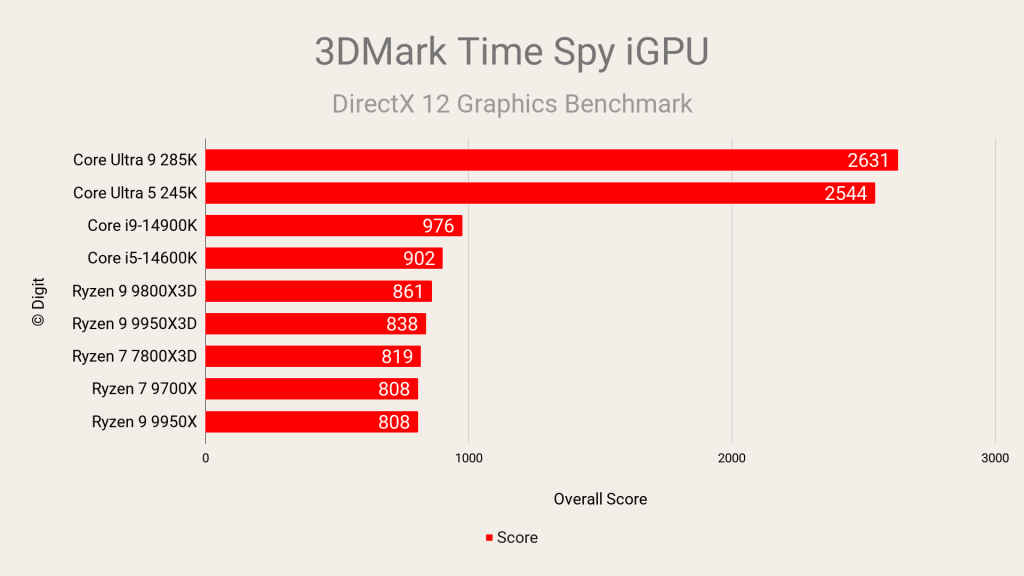
7 Game Average
While 3DMark is an excellent synthetic benchmark, it’s not really indicative of real-world gaming performance and that’s why we have to rely on popular AAA video games to assess how well the processor deals with contemporary video game engines. We revise the video games once every two years based on what’s most popular as per Steam and we also maintain a mix between different game engines.
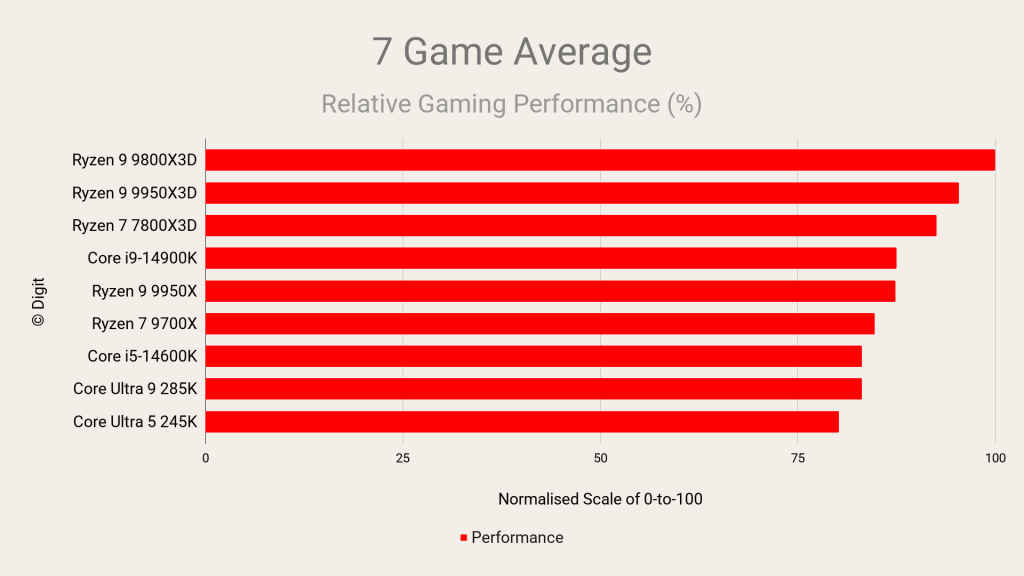
Core to Core Latency – AMD Ryzen 9 9950X3D
Core-to-Core Latency measures the time it takes for data to transfer between different cores within a CPU. It highlights the efficiency of the processor’s inter-core communication pathways and cache coherency mechanisms. An interesting insight is that lower core-to-core latency can improve performance in multi-threaded applications where threads need to synchronize or share data frequently. It can reveal architectural differences between CPUs, such as the impact of chiplet designs versus monolithic die layouts, affecting inter-core communication efficiency.
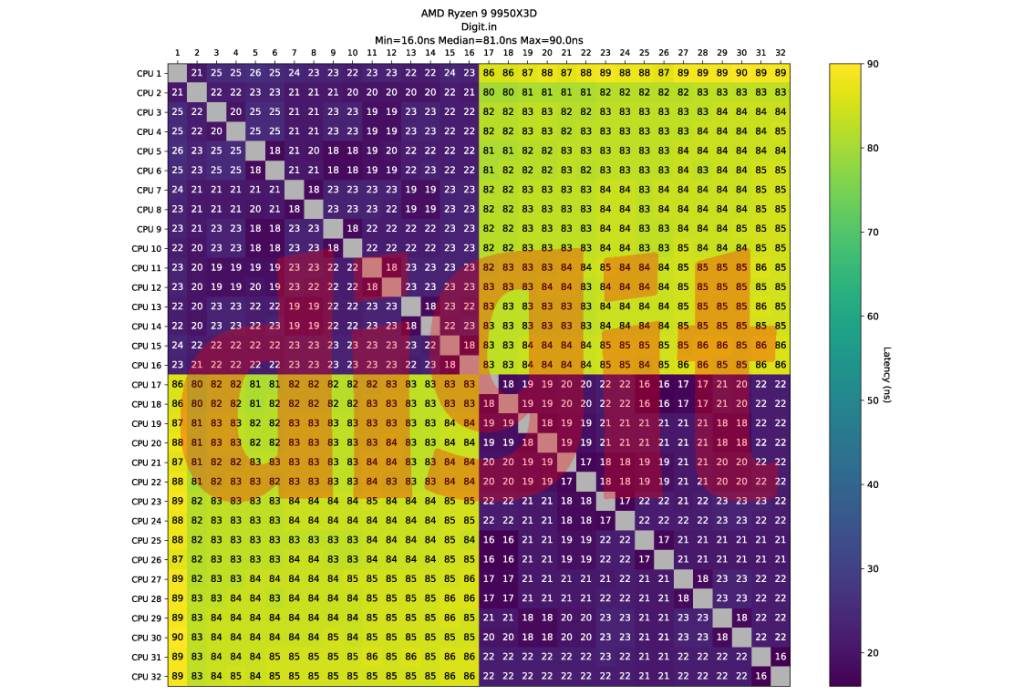
The AMD Ryzen 9 9950X3D has 16 Cores with two CCDs and we can see that within the CCD, the latency for core-to-core communication is around 21-24 milliseconds. And when switching to cores on the other CCD, the latency climbs into the range of 80-83 milliseconds. This is a marked improvement over the older gen processors wherein the communication between CCDs would incur a larger penalty.
AMD Ryzen 9 9950X3D Thermals and Power
Being a 16-Core processor does mean that the temperatures tend to skyrocket pretty fast, especially in multi-threaded workloads. With Cinebench and Blender, we did see the Ryzen 9 9950X3D creep up to 84 Degrees pretty fast. Using an AIO becomes absolutely essential.
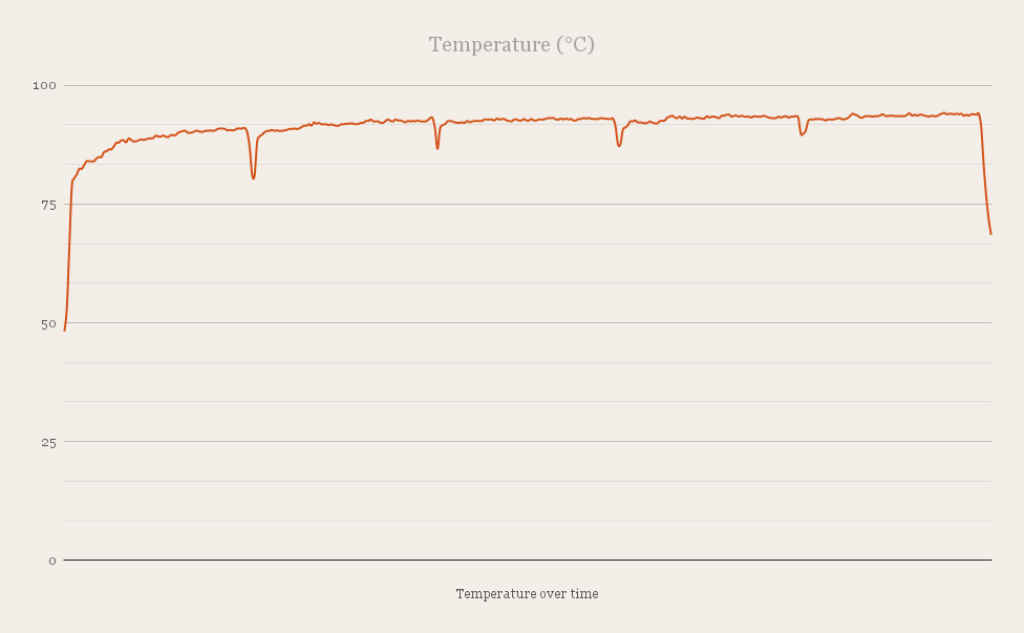
During our throttling test, we saw power draws hitting 200 Watts but the processor did not throttle. This is a little over the TDP for which the processor is rated for but a good cooler will not only help keep the processor cool but it will also help the inbuilt OC profiles do their job better.
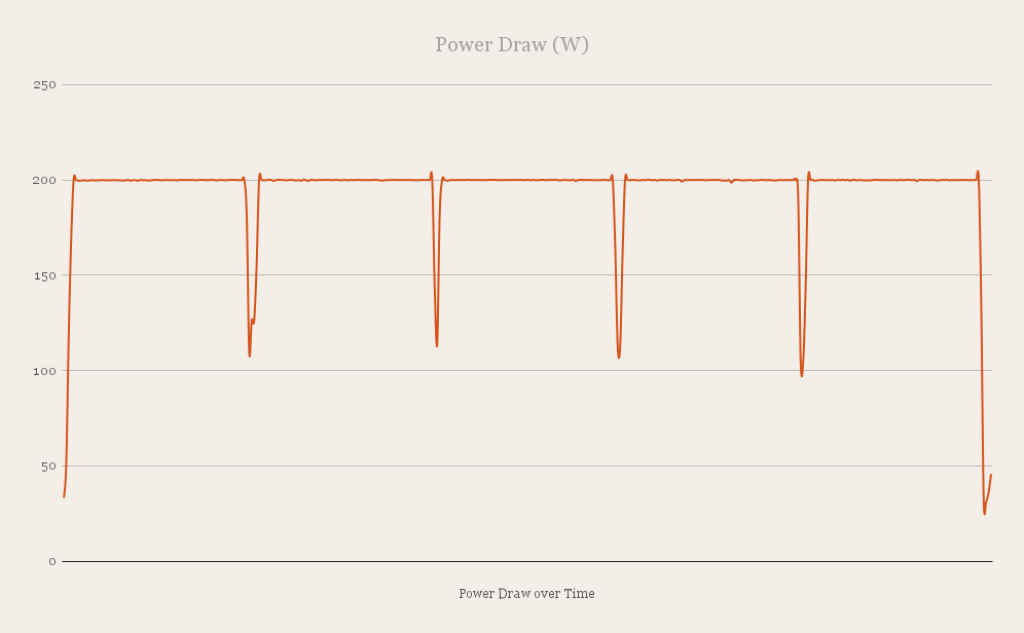
Verdict
The AMD Ryzen 9 9950X3D is a great processor will all the bells and whistles that one could hope for. The only “bell” missing would be that of power consumption. It does great in single-threaded workloads, content-creation workloads, gaming, … you name it. And to make all of these improvements worth the money, it should ideally list for a price of INR 70,000 in India. With the older gen 7950X3D still selling for about 65K while consuming much less power, folks who need the power have plenty of options to pick from.
AMD Ryzen 9 9950X3D Desktop Processor Key Specs, Price and Launch Date
| Release Date: | |
| Market Status: | Launched |
Mithun Mohandas
Mithun Mohandas is an Indian technology journalist with 10 years of experience covering consumer technology. He is currently employed at Digit in the capacity of a Managing Editor. Mithun has a background in Computer Engineering and was an active member of the IEEE during his college days. He has a penchant for digging deep into unravelling what makes a device tick. If there's a transistor in it, Mithun's probably going to rip it apart till he finds it. At Digit, he covers processors, graphics cards, storage media, displays and networking devices aside from anything developer related. As an avid PC gamer, he prefers RTS and FPS titles, and can be quite competitive in a race to the finish line. He only gets consoles for the exclusives. He can be seen playing Valorant, World of Tanks, HITMAN and the occasional Age of Empires or being the voice behind hundreds of Digit videos. View Full Profile




